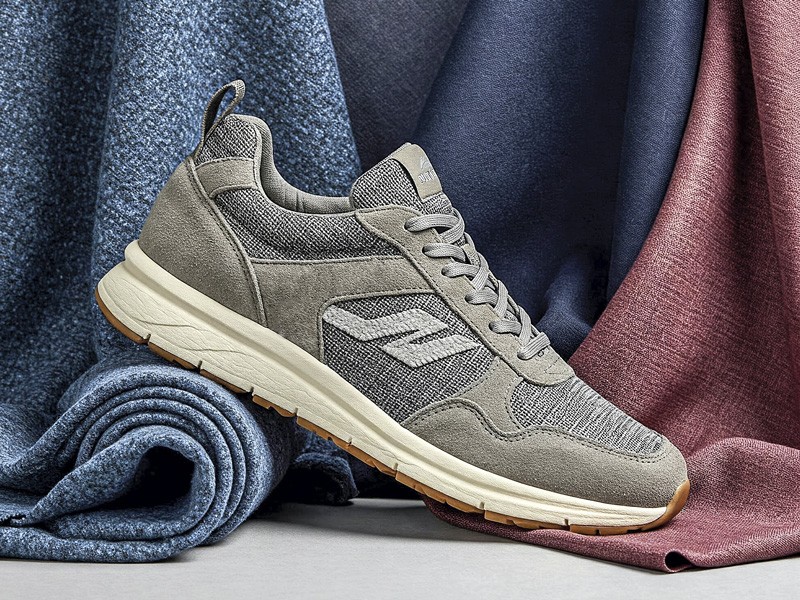


Footwear textiles are composed of various types of fibers, including cotton, wool, nylon, polyester, polypropylene, rayon, lycra, and many others.
Each has its own appearance and physical properties, such as hygroscopicity, elasticity, UV resistance, or colorfastness.
For footwear manufacturing, polyester and nylon are the most commonly used compositions. Elastic lycra and spandex are often used for bindings and linings. Cotton is essential for vulcanized sneakers, as synthetic fibers melt in vulcanization ovens.
Natural fibers such as cotton or wool accept finishing treatments (e.g., waxing), but these must be applied after shoe assembly, as they do not easily bond to the sole during assembly.

Nylon is the generic name used for a family of plastics, aliphatic or semi-aromatic polyamides. It can be injection molded or spun into fibers to create strong fabrics that resist microbes, are easy to dye, colorfast, and ideal for sneaker uppers. These textiles are sold under the brand name Cordura™.
Polyester is the trade name for polyethylene terephthalate (PET). Like nylon, polyester fabrics are tough, fungus-resistant, easy to dye, and colorfast, while absorbing very little water. Polyester is more UV-resistant and has a higher melting point than nylon. Its fibers are highly stain-resistant but can be difficult to dye. It has good moisture-wicking properties and can be woven to create lightweight, elastic structures.
These are made from the same material: a synthetic elastic polymer. Spandex is the commercial name for a synthetic polyurethane copolymer fiber known for its high elasticity. By weight, it is stronger and more durable than natural rubber. It can stretch over 500% of its original length and return to its original shape. It is commonly blended with other fibers to create strong and elastic fabrics. Due to its stretchability, Spandex fabric is ideal for bindings and tongue gussets. Lycra and Elastane share the same characteristics and properties.


Rayon is a semi-artificial fiber made from wood pulp. The cellulose extracted from the pulp is chemically solidified into a synthetic fiber. Types of rayon include viscose, modal, and lyocell. Rayon is slippery like nylon but more absorbent and cooler. Its high melting point makes it suitable as a heat-resistant fabric. Its slippery surface also provides antistatic properties.
Kevlar™ is the registered trademark of a synthetic para-aramid fiber. Kevlar has high tensile strength, five times stronger than steel. When woven into fabric, it is cut-, abrasion-, puncture-, and bullet-resistant. Kevlar is often blended with nylon or other high-strength fibers to reduce costs. Due to its molecular structure, Kevlar cannot be dyed and can be difficult to die-cut due to its toughness.
Nomex™ is chemically related to Kevlar but has lower strength. It offers high thermal, chemical, and radiation resistance, making it ideal for flame-resistant products. Footwear used in auto and motorcycle racing is often made with fireproof materials and Nomex fabric.

Linen is a fabric made from the fibers of the flax plant. It is somewhat difficult to manufacture and is widely used in warm climates due to its coolness, as the fiber is highly absorbent. In footwear, it is found in high-end casual models but not in high-performance sports shoes.
Silk is a natural fiber produced from the protein in silkworm cocoons and can be woven into fabric. Silk’s glossy appearance is due to its triangular prism-like structure, which reflects light at various angles, producing different colors. Silk is expensive and strong, though it loses about 20% of its strength when wet. It has some stretch but becomes misshapen, and must be reinforced when used in footwear production.
Wool fabric is used for indoor footwear, but it is also being applied to conventional and streetwear models. When unreinforced, it adapts to shape but is sensitive to water and wear. Wool is soft, breathable, thermoregulating, and moisture-absorbing. Today's footwear made with wool fabric or structures has standard reinforcements, thus maintaining its appearance without compromising durability.
Source: Footwear Material Guide / Wade and Andrea Motawi